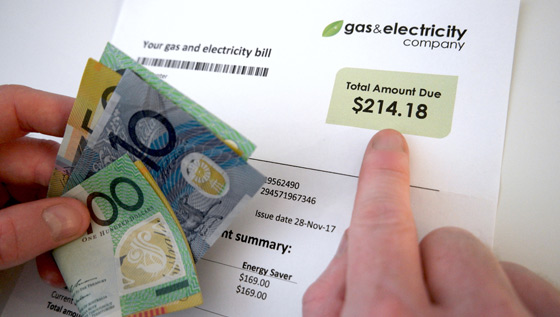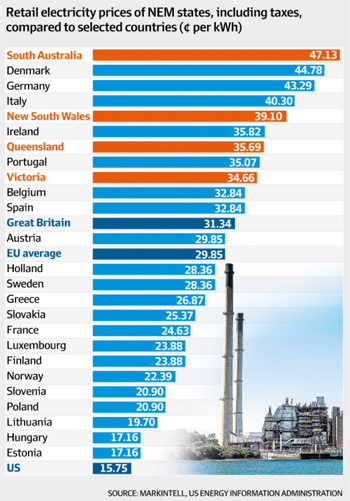
Under Strain – Can Housing Prices and Power Prices Derail the Australian Economy?
Australia – Part two: This article looks in detail at how both the state and federal governments’ conflicting policies are leading to both surging power prices and an energy crisis on the East Coast of Australia.
(Part one: www.ecovis.com/en/nder-strain-can-housing-prices-power-prices-derail-australian-economy)
Can power prices restrain economic growth in Australia? That is a key question that policy makers are grappling with as Australian households and businesses are faced with ever-increasing power prices.
Australia is suffering from extremely high power prices. This is illustrated by the following graph, from the Australian Financial Review using Markintell and US Energy Information Administration Data, which provides a comparison of retail electricity prices comparing Australian states participating in the National Energy Market (NEM) with other Western countries in 2016:

The important item to note in relation to the above chart is that Australian electricity is relatively lightly taxed when compared to European electricity generation. Even without significant taxation, Australian electricity is therefore still at or near the top of the pricing chart.
A Failure of Policy?
In Australia, at least, the public makes the Government shoulder (probably unfairly!) a disproportionate share of responsibility for most things which go wrong. However, in our opinion, electricity prices are a classic case where no-one else can really be blamed for what has happened and both the State and Federal Governments share the blame for how the system has become so broken.
Since the 2009 introduction of the Carbon Pollution Reduction Scheme (CPRS) by the Rudd Government, at a federal level there has been no agreement on energy policy between the major political parties. There then followed withdrawal of the CPRS, the introduction of the Carbon Tax, the subsequent withdrawal of the Carbon Tax, the failure of the direct action plan and threats by the Government to both curb gas exports and attempt to force owners of coal powered fire stations to keep them open. Throughout, the Federal Government has been about as unhelpful as they could be in providing investment certainty to allow the construction of major new generation capacity. They have also successfully managed not to agree on a clean energy target which has left investment in renewable energy in limbo.
At the same time as this, the State Governments have also helped to restrict the development of generation by:
- New South Wales and Victoria making it virtually impossible to develop on-shore sources of gas
- privatising energy infrastructure, including both generation and transmission assets.
In order to maximise the price of the transmission assets, State Governments have been accused of “gold plating” their networks, which have in turn been responsible for most of the dramatic escalation in power prices over the last decade. The problem is the pricing mechanism for the transmission providers, with two thirds of the transmission networks earnings guaranteed by being linked to the value of the network. So the higher the value of the network, the higher the charge the network can levy on customers. According to the Australian Competition and Consumer Commission (ACCC) this has created a self-serving cycle where it is in the transmission network owner’s best interest to over-invest in the network in order to earn a greater return. As an example of this over-investment, the Australian electricity transmission network is valued at US$75 billion and serves 25 million people. The entire United States electricity transmission network, which serves 320 million people, is valued at US$100 billion. This stark number demonstrates the core problem which only State Governments are responsible for creating.
 Australia needs to get a grip on its energy crisis. Otherwise we shall see businesses moving out of Australia, taking jobs and prosperity with them.
Australia needs to get a grip on its energy crisis. Otherwise we shall see businesses moving out of Australia, taking jobs and prosperity with them.
Generation capacity
Even without the “gold plating” of the transmission network, Australia still has an issue of under-investment in generating capacity. This is especially acute as older coal fired power stations are de-commissioned with no equivalent generating asset replacing them, as a result of the lack of clarity over Federal Government energy and climate policy.
The response of the Federal Government has been to announce the investigation of expanding the Snowy Hydro generation to include pumped hydro, while the South Australian Government, being the most vulnerable due to their reliance on baseload coal power generation from Victoria, has announced plans to build both a new gas fired power station and a new battery storage facility.
Indeed South Australia, seen at the top of the pricing chart, has been especially affected by electricity prices and has suffered blackouts during peak days due to key failures within the power grid. However, a novel approach to attempt to fix these has been proving its worth over the current summer season.
Tesla to the rescue in South Australia
South Australian power generation has the highest percentage of renewable generation sources in Australia, with over 50% now being generated from sun- and wind-based sources. While this is great for the environment, it has meant that when problems have arisen in the transmission network connecting Victoria and South Australia, widespread blackouts have occurred with South Australian-based energy generation being unable to cope with the increased demand.
Enter Elon Musk and Tesla who, after South Australia suffered crippling blackouts over the last two years, has built the world’s largest lithium-ion battery to serve as a backup for the network. While the Federal Government was critical of a “band-aid” solution being applied, the battery proved it was a viable option in December last year when it delivered enough energy into the market to prevent blackouts occurring when the biggest coal fired power station temporarily went offline. The South Australian Government is so happy with the result that they are planning further investment in battery storage. While this has temporarily solved one issue for South Australia, significant questions over the cost of generation within the state remain unresolved.
The future
Solving the energy crisis will need co-operation from both State and Federal Government policy makers, which has so far not been forthcoming. It has been easier for them to attempt to blame each other. However, a failure to solve this problem and ensure both adequate supply and reasonable prices will see businesses move out of Australia, taking jobs and prosperity with them.
Author:
Scott Hogan-Smith
CA – Chartered Accountant (AE)
ECOVIS Clark Jacobs, Sydney, Australia
scott.hogan-smith@ecovis.com.au
Contact us:
ECOVIS Clark Jacobs
Level 2, Piers 2 & 3, 13 Hickson RoadNSW 2000 Walsh Bay, Sydney
Phone: +61 2 9264 1111
www.ecovis.com/australia

